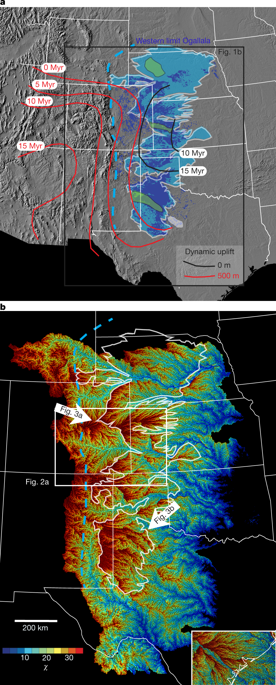Our official English website, www.x-mol.net, welcomes your
feedback! (Note: you will need to create a separate account there.)
Transience of the North American High Plains landscape and its impact on surface water
Nature ( IF 50.5 ) Pub Date : 2018-09-01 , DOI: 10.1038/s41586-018-0532-1 Sean D. Willett , Scott W. McCoy , Helen W. Beeson
Nature ( IF 50.5 ) Pub Date : 2018-09-01 , DOI: 10.1038/s41586-018-0532-1 Sean D. Willett , Scott W. McCoy , Helen W. Beeson

|
Ecosystem diversity and human activity in dry climates depend not just on the magnitude of rainfall, but also on the landscape’s ability to retain water. This is illustrated dramatically in the High Plains of North America, where despite the semi-arid modern and past climate, the hydrologic conditions are diverse. Large rivers sourced in the Rocky Mountains cut through elevated plains that exhibit limited river drainage but widespread surface water in the form of ephemeral (seasonal) playa lakes1, as well as extensive groundwater hosted in the High Plains aquifer of the Ogallala formations2. Here we present a model, with supporting evidence, which shows that the High Plains landscape is currently in a transient state, in which the landscape has bifurcated into an older region with an inefficient river network and a younger, more efficient, river channel network that is progressively cannibalizing the older region. The older landscape represents the remnants of the Ogallala sediments that once covered the entirety of the High Plains, forming depositional fans that buried the pre-existing river network and effectively ‘repaved’ the High Plains3–6. Today we are witnessing the establishment of a new river network that is dissecting the landscape, capturing channels and eroding these sediment fans. Through quantitative analysis of the geometry of the river network, we show how network reorganization has resulted in a distinctive pattern of erosion, whereby the largest rivers have incised the older surface, removed fan heads near the Rocky Mountains and eroded the fan toes, but left portions of the central fan surface and the Ogallala sediments largely intact. These preserved fan surfaces have poor surface water drainage, and thus retain ephemeral water for wetlands and groundwater recharge. Our findings suggest that the surface hydrology and associated ecosystems are transient features on million-year timescales, and reflect the mode of landscape evolution.The High Plains region of North America is in a transient state, with a younger, efficient network of river channels progressively cannibalizing an older, less efficient region, aiding water retention for wetlands and groundwater recharge.
中文翻译:

北美高平原景观的瞬态及其对地表水的影响
干旱气候中的生态系统多样性和人类活动不仅取决于降雨量的大小,还取决于景观的保水能力。这在北美高平原得到了戏剧性的说明,尽管那里是半干旱的现代和过去气候,但水文条件却是多种多样的。源自落基山脉的大河流穿过高地平原,这些平原表现出有限的河流排水,但以短暂(季节性)海滩湖泊的形式存在广泛的地表水,以及存在于奥加拉拉地层高平原含水层中的大量地下水。在这里,我们提出了一个带有支持证据的模型,该模型表明高平原景观目前处于过渡状态,其中景观已分叉为具有低效河网和年轻、更高效、河道网络正在逐步蚕食旧地区。较旧的景观代表了曾经覆盖整个高原的奥加拉拉沉积物的残余物,形成了沉积扇,掩埋了先前存在的河网并有效地“重新铺设”了高原3-6。今天,我们正在目睹一个新的河流网络的建立,它正在剖析景观、捕获河道并侵蚀这些沉积扇。通过对河网几何形状的定量分析,我们展示了网络重组如何导致独特的侵蚀模式,其中最大的河流切割了较旧的表面,移除了落基山脉附近的扇头并侵蚀了扇趾,但留下了部分中央扇面和奥加拉拉沉积物基本完好。这些保存下来的扇面地表水排水不良,因此保留了用于湿地和地下水补给的临时水。我们的研究结果表明,地表水文和相关生态系统是百万年时间尺度上的瞬态特征,反映了景观演化的模式。北美高平原地区处于瞬态状态,河道网络逐渐年轻化、高效化蚕食旧的、效率较低的地区,有助于湿地保水和地下水补给。
更新日期:2018-09-01
中文翻译:

北美高平原景观的瞬态及其对地表水的影响
干旱气候中的生态系统多样性和人类活动不仅取决于降雨量的大小,还取决于景观的保水能力。这在北美高平原得到了戏剧性的说明,尽管那里是半干旱的现代和过去气候,但水文条件却是多种多样的。源自落基山脉的大河流穿过高地平原,这些平原表现出有限的河流排水,但以短暂(季节性)海滩湖泊的形式存在广泛的地表水,以及存在于奥加拉拉地层高平原含水层中的大量地下水。在这里,我们提出了一个带有支持证据的模型,该模型表明高平原景观目前处于过渡状态,其中景观已分叉为具有低效河网和年轻、更高效、河道网络正在逐步蚕食旧地区。较旧的景观代表了曾经覆盖整个高原的奥加拉拉沉积物的残余物,形成了沉积扇,掩埋了先前存在的河网并有效地“重新铺设”了高原3-6。今天,我们正在目睹一个新的河流网络的建立,它正在剖析景观、捕获河道并侵蚀这些沉积扇。通过对河网几何形状的定量分析,我们展示了网络重组如何导致独特的侵蚀模式,其中最大的河流切割了较旧的表面,移除了落基山脉附近的扇头并侵蚀了扇趾,但留下了部分中央扇面和奥加拉拉沉积物基本完好。这些保存下来的扇面地表水排水不良,因此保留了用于湿地和地下水补给的临时水。我们的研究结果表明,地表水文和相关生态系统是百万年时间尺度上的瞬态特征,反映了景观演化的模式。北美高平原地区处于瞬态状态,河道网络逐渐年轻化、高效化蚕食旧的、效率较低的地区,有助于湿地保水和地下水补给。









































 京公网安备 11010802027423号
京公网安备 11010802027423号